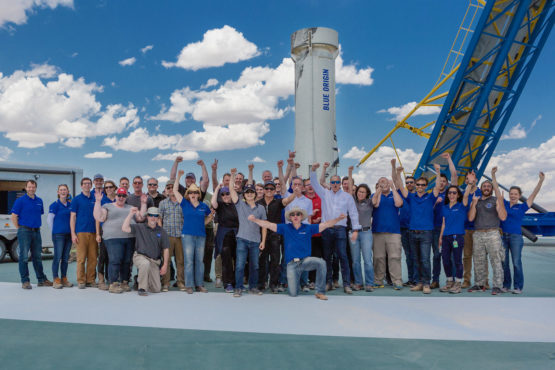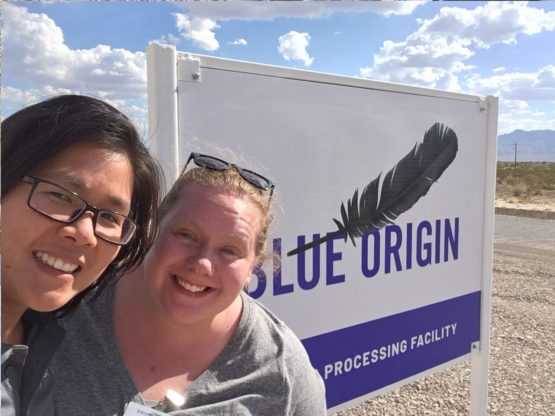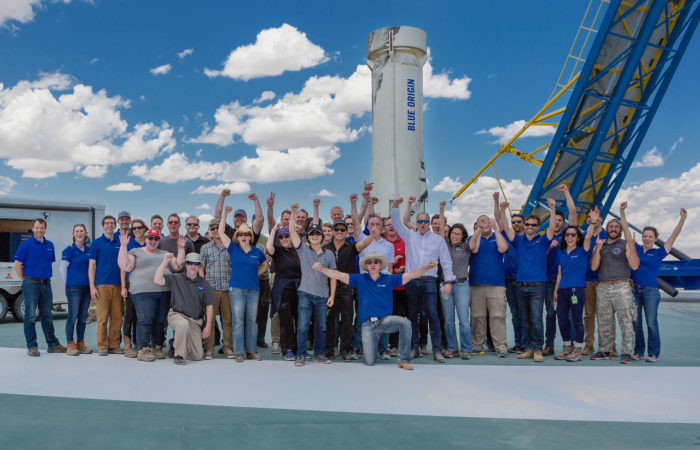New Shepard Mission 8
By Julia Hoskins, Internal Payloads Mission Manager, NanoRacks
and Mariel Rico, Operations Engineer, NanoRacks
Here at NanoRacks, we have the amazing job of integrating customer payloads for Blue Origin’s New Shepard space vehicle. We are watching a growing space industry, quite literally, from the ground, up. Some of us on the NanoRacks team are recently new to the space industry (Julia) but we get to work with experienced launch pros (Mariel) to help ensure mission success for the science, technology, and education experiments on board New Shepard.
We wanted to share a little bit about our experience in West Texas for New Shepard Mission 8, and the excitement of flying a payload on a Blue Origin launch!
So let’s rewind back to the Mission 8 launch weekend.

Photo Credit: Blue Origin
The “hard” part is done – you’ve built a payload, tested it, and you’re ready for the launch. So you fly to the West Texas launch site. When you arrive, Blue Origin provides lab space for preparation work to customers who need it. We started our work here, gathering with Blue Origin staff, then our payload customers.
This is often the first time we get to meet our customers face-to-face, even after working together through the integration process for months. There is a feeling of camaraderie, because even though this is our first official meeting, everyone from Blue Origin to NanoRacks to the customer teams are invested in doing their best to successfully gather scientific data points or confirming the functionality of technology demonstrations.
Between packing, prepping, and charging experiments, scientists lit up explaining hypotheses and objectives. The energy in the lab was vibrant.
New Shepard Mission 8 carried a great range of experiments, from the effects of microgravity on genes to environmental sensor testing, which helps one realize just how little we know about microgravity and just how much growing and exploration humans have left to do.
For us, launch day actually started in the middle of the night. To load batteries or biological samples as late as possible means starting work before sunrise. One of the stand-out features of Blue Origin flights is that customers can put sensitive science into their experiments very close to launch. Payload customers worked in the pre-dawn hours to do final preparations, just hours before New Shepard would take to the skies. With critical tasks complete and nothing left but to wait, many of us tried to catch some sleep. Thunderstorms that would slightly delay launch were perfect background for a nap. We woke up just in time to see a beautiful orange moon slip back behind the Texas mountains. Customers and staff sat together to watch the sun come up.

Fueled by coffee, sugar, and adrenaline, we piled in cars to our launch viewing area. Anticipation continued to build. We counted down from ten together and watched the vehicle lift off with pure awe. New Shepard looked smaller and smaller as it climbed, then disappeared. Blue Origin staff called out Max Q, apogee, crew capsule separation, and other milestones. We crowded together to look for the vehicle to return to sight. A customer spotted it first. It dropped with astonishing speed, before the engine re-lit and New Shepard made a beautiful controlled vertical landing.
Attention turned back up to watch for the reappearance of the crew capsule. We watched it come down quickly, then deploy parachutes to make a soft landing. The dry Texas dessert let off a puff of dust, signaling the payloads’ return to Earth. The customers and Blue Origin personnel with us were ecstatic. It was incredible to share such an experience with people who had worked so hard to get to this moment.
We returned to the Payload Processing Facility to wait for payloads to return. Everyone was so excited to have science in hand. There was another moment of joy as they opened payloads to see that experiments had gone as planned. Teams worked quickly to save data and process samples.
Science was packed and shipped home for further experiments, and celebrations commenced.
All in a day’s work!
It is exciting for us at NanoRacks to work with such a dynamic team at Blue Origin and play a role in offering multiple pathways for space research. Suborbital space is the perfect testbed before launching to the International Space Station, and something we definitely recommend to NanoRacks’ customers around the world.
We can’t wait to see how the New Shepard program continues to grow and make space research more accessible than ever before.
‘Til the next launch,
Mariel & Julia

